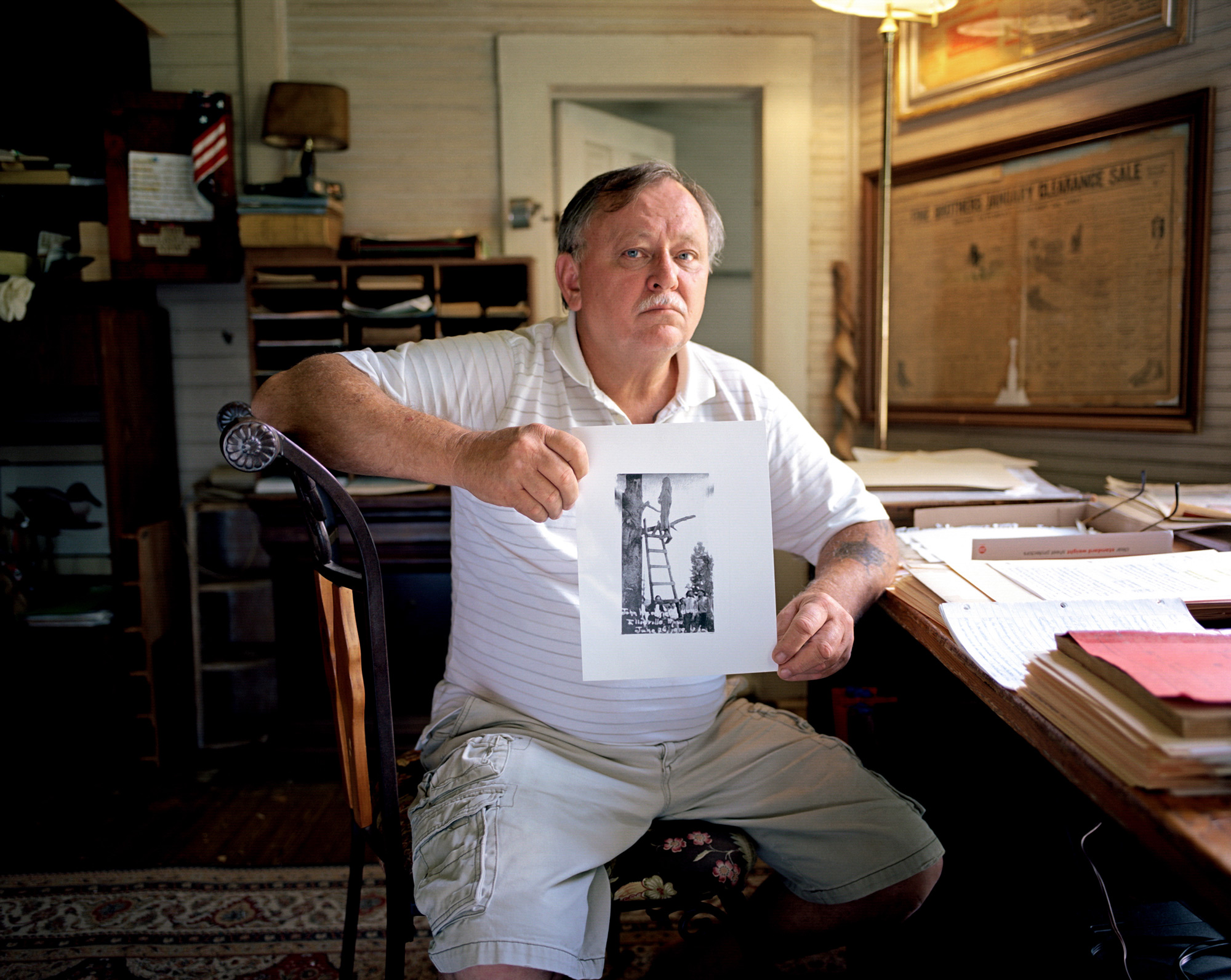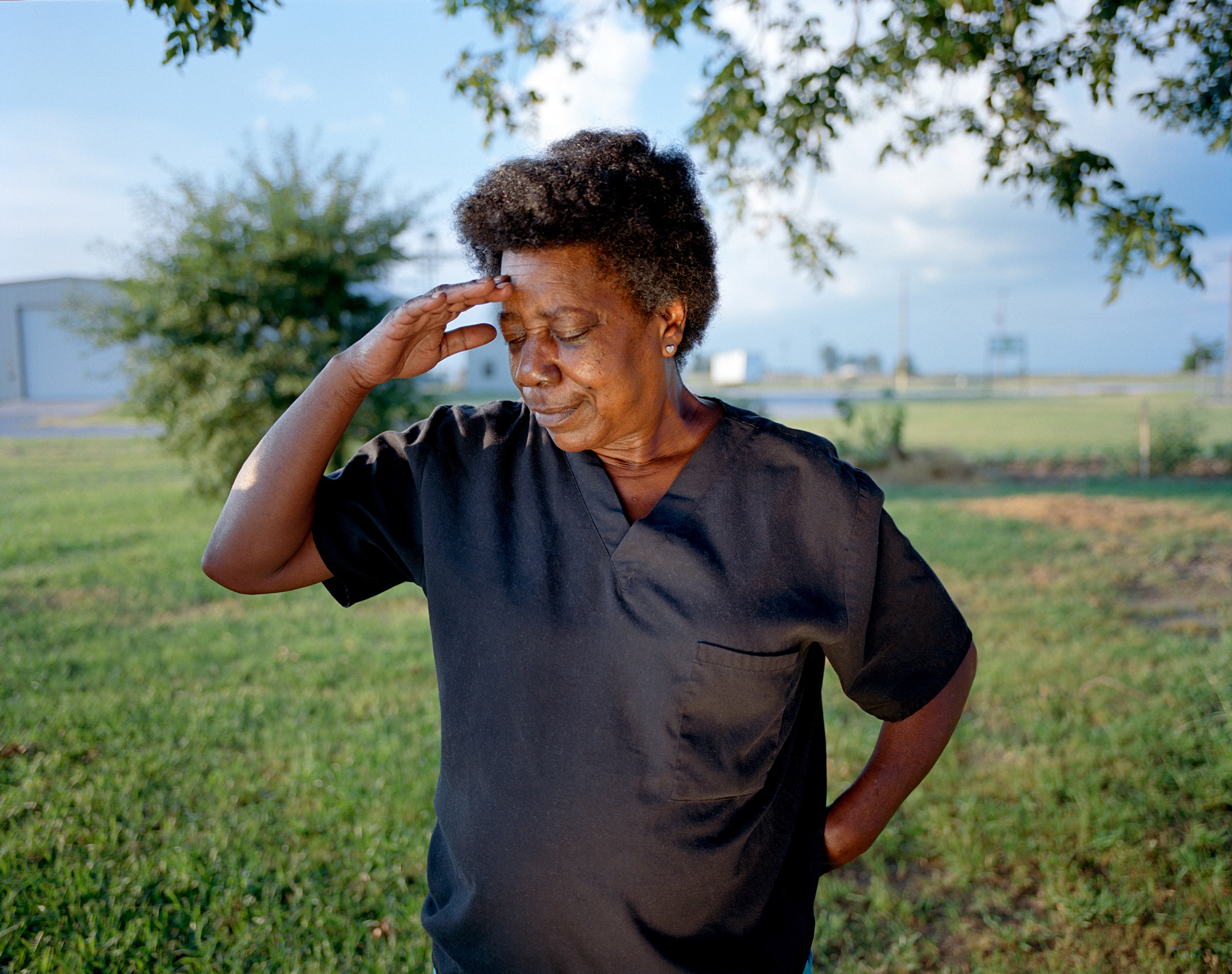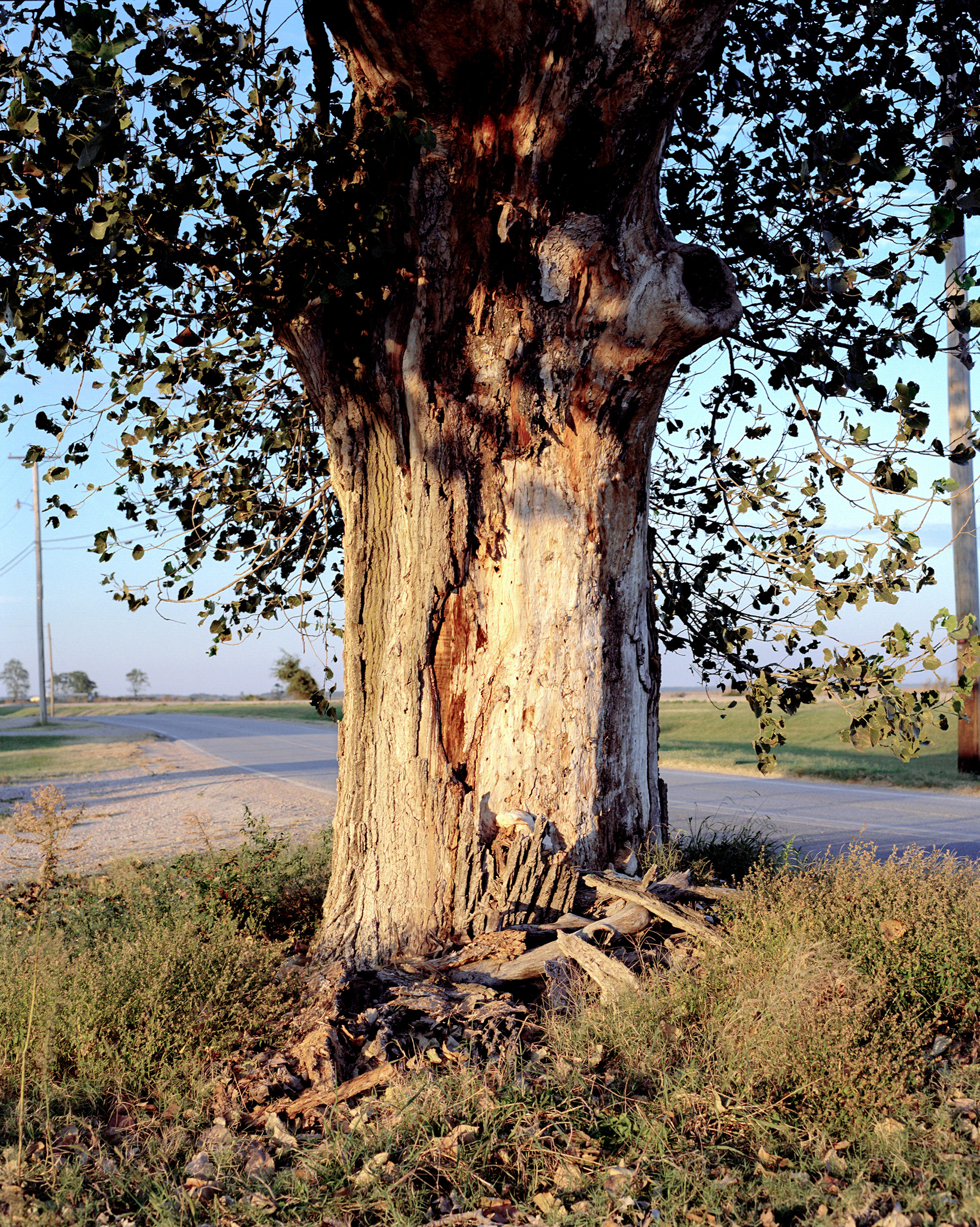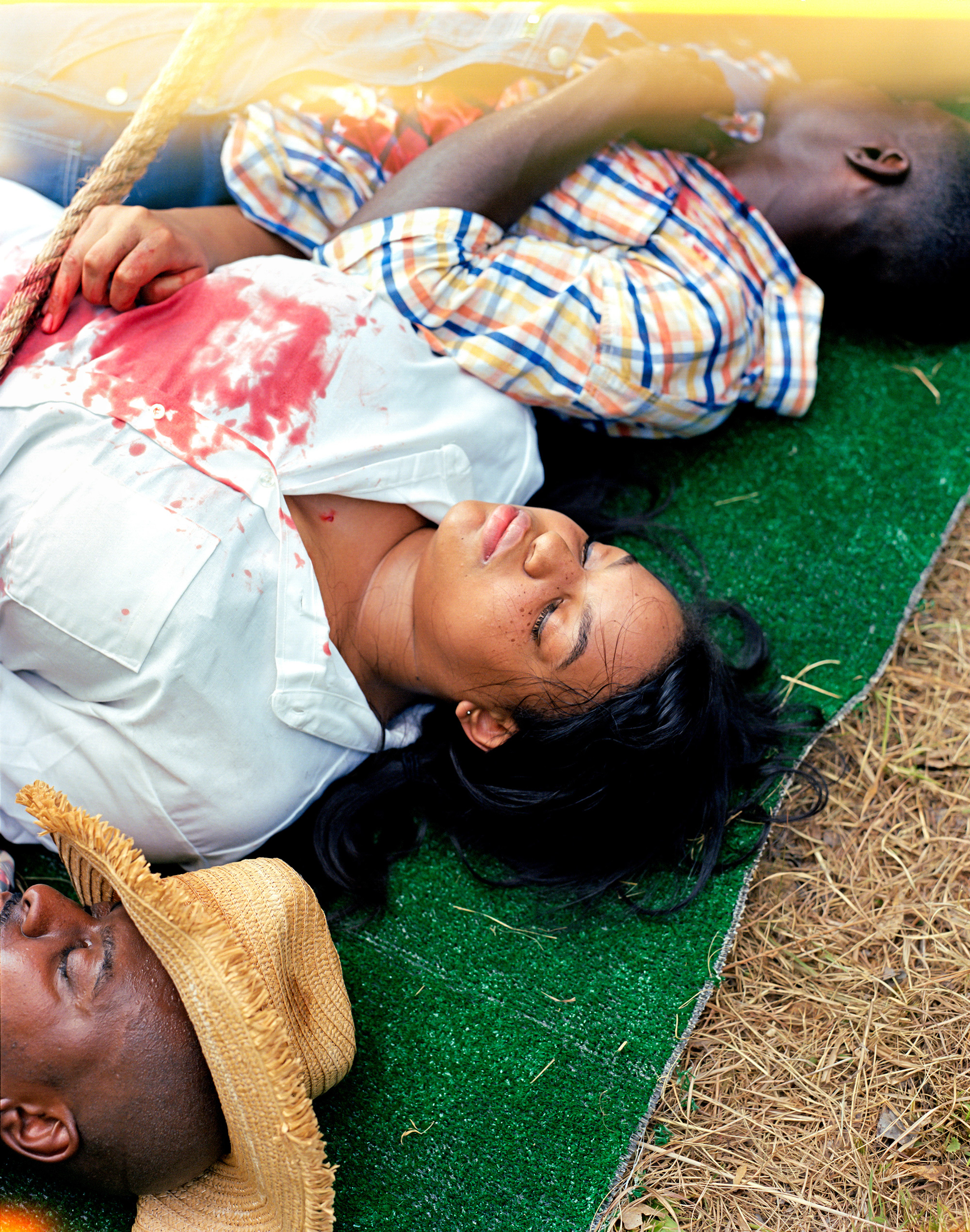In 2017, photographer Johnathon Kelso began a project to test himself and his faith. This white Florida native decided to document lynching sites in six Southern states and to talk with the victims’ descendants. It was, Kelso says, a mission from God. And it is clearly one Southerner’s heartfelt attempt to extend his hand across a painful old divide.
Photographs by Johnathon Kelso | Words by Tim Turner
A lifetime of white privilege allowed Johnathon Kelso to avoid difficult conversations about race. But his faith would not. His heart had ached too long, and his eyes had seen too much to remain silent.
So, beginning in the spring of 2017, the photographer began a series of visits to sites where lynchings happened in six Southern states. The resulting photos — a project he dubbed “A Song Without Words” — are modern-day mirrors of horrific acts of domestic terrorism visited upon black men, women, and children throughout the region with impunity from either police or pulpit.
Few want to talk honestly about Southerners’ moral nullity as relates to their treatment of blacks. But Kelso hopes these images will help stimulate authentic conversations among the races. Being honest about race and the ugly history of lynching in the South represents spiritual growth for the Atlanta-based Kelso. He’s a Christian, which led him to examine himself on a far more personal level than he’d ever dared, which led us both to the foyer of his church in Decatur, Georgia.
Kelso choosing to meet at his church was as right as it was appropriate. Trinity Anglican Mission was his place of conversion and conviction. Just inside the doorway of this strip-mall sanctuary, Kelso arrayed on the foyer floor a dozen of his images — each beautifully composed, yet sheathed in histories of lynchings and murders of blacks throughout the South.
Kelso is a proud congregant here, in part thanks to his church’s effort to do something about the lack of diversity in its congregation.
“That's something that's wrong with the church,” Kelso said. "Church with a Big C. You've heard it said that 11 a.m. Sunday is the most segregated hour. That's a problem. That's a big problem.” When Trinity Anglican Mission took up the issue, congregants were shown a clip from a talk by Bryan Stevenson, the founder and executive director of the Alabama-based Equal Justice Initiative and the driving force behind the recently opened National Memorial for Peace and Justice in Montgomery.
Stevenson's words resonated with Kelso.
Rodkevian Thomas, an intern with the Emmett Till Interpretive Center, visits the restored service station adjacent to the dilapidated Bryant's Grocery in Money. On August 24, 1955, Till was at Bryant’s Grocery when he allegedly violated the racial customs of the day by flirting with or whistling at Carolyn Bryant. But more than five decades later, Bryant admitted to historian Timothy Tyson, author of The Blood of Emmett Till, that she had fabricated testimony about her interaction with Till in 1955.
“I saw that (Stevenson) and others like him were acknowledging this history, the convoluted history of the South,” Kelso said. “For me, he was owning it, and he was tackling it in a way that was really hard, being heartfelt. So, I said, 'Okay, that's it.' I felt a leap in my heart, like this is something I should seek after, and so I prayed about it and started to research and just felt convicted by the Lord to move in this area. It just became a desire to move forward into a space of history that I've never been taught. That's kind of how the project began. It was through the church basically challenging us as a congregation to figure out why we're not a diverse church.”
That challenge forced Kelso to deal with his own upbringing. His Niceville, Florida, childhood was a comfortable distance away from people of color. His faith told him he needed to be around people who were not like him, but he had never, volitionally, done that. Which is why, until he undertook this project, he was as removed from the suffering of blacks as one could be.
“My worldview, whether I like it or not, has been seen through the lens of people with white skin like mine,” Kelso said. “And my perspective has been constrained to the comfortable ease of the mirror rather than to the difficulty of diversity.
“If this project has prescribed any remedy for such a sin sickness, it has been that of repentance and sorrow for how practically idealistic I’ve viewed my own race and religion. After all, it was the white church of the South that has permitted and condoned its own national pastime of crucifying black bodies with such unfeigned satisfaction. W.E.B Du Bois pointed at the truth when he said, ‘A nation’s religion is its life, and as such white Christianity is a miserable failure.’"
That failure is unacceptable to Kelso. If things were to change, he knew it had to start with him when he had the chance. He remembers one such chance presenting itself one morning in a Grant Park coffee shop where he and two African-American women seated at a table behind him, were the only patrons. He was close enough to overhear their conversation. It was race-related, but he couldn’t exactly make it out. At that moment, Kelso decided he would go to their table and show them his work.
“I wanted their feedback,” Kelso said. “As I was walking over there, I started to shake and lost my voice. I love to talk to strangers, but I found myself completely ashamed of what I was about to show them. I was completely scared."
Scared because he knew what feelings could possibly be invoked from images he came across during research of lynchings across the South. Kelso found a photo taken in Paris, Texas, on Wednesday, February 1, 1893. Instead of the town's citizens preparing for, say, that evening’s Bible study, 10,000 people gathered to witness Henry Smith — a black man accused of raping and murdering a four-year-old girl — being hanged and burned alive.
The people’s attire for the lynching affected Kelso most. Nevermind that the lynching happened midweek: The crowd was in its Sunday best. “This was something that was so mind-boggling to me, because before this project began, I assumed that lynchings were done in the dead of night, by Klansmen and those who were on the fringe,” Kelso said. “But it wasn’t.”
In Tallahatchie County, Mississippi, where 14-year-old Emmett Till was tortured and then murdered, there are at least 30 historical sites connected with his abduction and murder of Till. But this barn, the site of Till’s torture, sits unmarked on the property of Jeff Andrews in the town of Drew.
Seeing the old photos and capturing his own throughout the South forced Kelso to face his biases and laziness relative to race.
“Throughout the project, I was haunted with guilt that I’m only now able to sift through and consider,” Kelso said. “Learning of this hidden American history has devastated my heart and altered how I view the Southern landscape and its people. A veil has been lifted from my eyes, and now even the ground below my feet cries out saying, 'What have you done?'
“The unsettled stillness of these places was shrouded in such heavy darkness that I would weep alone in some church cemetery where a black body was tied to a tree stump and burned alive, or I’d be utterly afraid of an oncoming vehicle’s headlights as they approached my position on a highway’s bend where lynched bodies were buried in unmarked graves. However, it is of little consequence to have your heart broken, yet left unchanged.”
Not until he traveled to places where lynchings of blacks happened and talked to the families of victims did he begin to understand. He needed to see and hear for himself the stories of others and take ownership.
“But not in a way to say like, ‘Let me own that, too,’” Kelso said. “It's more like, ‘Let me be sensitive. Let me be courageous in a way that I haven't been before, so that I can get to know people who are different than me.’ That's one of the ways. Another way is my heart has been broken for the history that we have toward African-Americans in the South. I think my sensitivity toward racial injustice and the hurt that lies in the ground of the South toward African-Americans and those who are different than me is completely changed. I'm open to that sensitivity hitting me. I got a lot of growth to do. I'm not where I'd like to be, I guess."
Initially, Kelso envisioned visiting the lynching sites and photographing how they look now — not to compare and contrast them with old photos, but to look at the sites as pieces of history. His heart, with an interest beyond recording the landscape, said something else.
"It was because these lynchings have histories, these events that happened in specific communities affected people for generations," Kelso said. "You can go to these places now and still feel these effects, these very real ways of living that have been impacted so greatly by these lynching histories. So, to just photograph the parking lot or the gas station or the field didn't feel to me like it carried weight, as much as meeting a person who was carrying that burden, and trying to seek justice, and trying to find peace in a really dark place.
"That's what the photographs are. Coming face to face with those who are carrying this burden, trying to remedy and fix and move forward. Or at least honestly say this is something that happened in their history."
Ellisville, Mississippi — Johnny Pool is a local historian whose parents attended the 1919 lynching of John Hartfield. Pool has collected information on lynchings throughout Jones County, MS and is seen here holding a photograph taken during Hartfield’s lynching, was one of the largest mass-spectacle lynchings to take place in the South. The local paper spread the news of the planned event by proclaiming, "John Hartfield will be lynched by Ellisville Mob at 5 o’clock this afternoon.” Thousands of people poured in that evening to witness Hartfield as he was riddled with bullets, hung from a tree, and then burned. Photo postcards of the brutal spectacle were sold afterward and a gleeful spectator even boasted of cutting a finger from the corpse to keep as a souvenir.
Kelso sees his months of immersion in these tragedies as only the start of his education, the beginning of more conversations to come.
“I have much to learn from oppressed peoples, the least of these, people who still shout 'Amen' or cry 'Hallelujah' although every power is against them,” Kelso said. “We have much to learn from those who can’t sit idly by, waiting for justice, but are instead compelled to carry the crosses of their brothers and sisters up Golgotha’s hill in Jerusalem — or the Edmund Pettus Bridge in Selma, Alabama.
“The time is ripe in the South to confront our history of racial violence and the racial indifference of whites claiming to be 'woke.' For me, that starts around the kitchen table and with who I invite into my home; by having tough conversations and asking awkward questions to people of color who can call bullshit when my delusional inner awakenings don’t line up with how I live in the day-to-day. I hope not to be so 'woke' that I remain complacent and ineffective without action or duty to God’s vision — in which every tribe, nation, people, and language are one.”
The Equal Justice Initiative has documented over 4,000 lynchings from 1877 to 1950. Kelso visited locations where he could find people who would cooperate with him and talk about the histories of those places and the people connected to them. The following is a selection of the photographs from "A Song Without Words," along with Kelso's observations.
One possible mass-grave site in Elaine, Arkansas. Stories passed down to community members in Elaine often stress the remembrance of mass graves in the area.
Ora Scaife reflects on the atrocities committed during the 1919 race massacre in Elaine, Arkansas, where over 200 African-Americans were murdered within a three-day span. Elaine sits in Phillips County in the Arkansas Delta, and Scaife and her family have lived in the county for generations. However, for reasons unknown to Scaife, specific stories surrounding the massacre were not handed down. Instead, Scaife recalled that when she was a child, her family would whisper at the kitchen table about the massacre and send her back to bed if she was caught listening.
The African-American community in Elaine has often heard stories from their parents or grandparents recalling various locations of hanging trees used in Phillips County during the 1919 Race Massacre. One Elaine resident remembered, “My grandmother said that’s where they hung a man. She said he’d stayed there weeks and everybody was scared to cut him down.” “We would walk by it as kids and get spooked. Everyone in the neighborhood knew about it.”
Dequincy Wilson sits on the steps of an old general store located in downtown Elaine. The people of Elaine often describe the place as being two towns due to the racial divide between the African-American and white communities.The events of the massacre, which occurred in 1919, are rarely brought up within the community, and the younger generation has little to no remembrance of the town’s convoluted history.
James White stands in a field behind the Elaine Legacy Center. White has lived in Elaine his entire life and first learned of the 1919 Elaine Massacre from his grandparents, who worked as sharecroppers at the time. During the three-day massacre, the county sheriff organized a posse of armed men from the surrounding counties of Arkansas and Mississippi, and Gov. Charles Brough called in federal troops to quell the violence. White remarked on the use of the federal troops: “My grandparents told me they had to hide in the woods. … They said when the soldiers came it didn’t get no better because the soldiers was killing people, too.”
Gene Bowen holds a photograph of his parents at his home in LaGrange. Bowen was 6 years old when he awoke on a Sunday morning in 1940 to find his parents outside the home attending to a young African-American man, Austin Callaway, found bleeding to death on their property. The family wrapped the unconscious man in a bedsheet and rushed him to the local hospital where he later succumbed to his wounds. Callaway had been arrested the evening before and was snatched from police custody without resistance by an armed group of hooded men. He was then driven to the edge of town, shot multiple times, and left to die.
People in Lawrenceville flock to the downtown square every weekend for free movies on the lawn, Tex-Mex food, and a number of hip gastropubs within walking distance of the courthouse lawn. In 1993, a local Sons of Confederate Veterans group erected a monument to their Confederate dead on the square with the inscription, “Lest We Forget.” However, if you ask anyone in town, or even the local historical society, about the 1911 public lynching of Charlie Hale, which played out on the same square in broad daylight, you will find little to no remembrance. In a souvenir photo postcard taken at the time of the lynching, crowds of white men are pictured with hound dogs and young boys surrounding the dead corpse. A sign was attached to Hale’s toes. It read, “Please do not wake him.”
On April 7, 1911, Charlie Hale was arrested for assaulting a white woman but was later dragged from his jail cell and hanged on the courthouse square in broad daylight. Cynthia Rintye, the director of Lawrenceville Ghost Tours, visits the old county jail in Lawrenceville, which is believed to be where Hale was detained before his murder. Lawrenceville Ghost Tours adapted the events of Hale’s lynching, and the story of his death titled “Alone in the Courthouse”, can be heard every night in October for $15. Tour guides are advised on issues of cultural sensitivity surrounding the story. A training pamphlet directs that if a child under the age of 10 asks what a lynching is, a tour guide should say, ‘It’s something that’s very bad, but we’re lucky it doesn’t happen anymore.”
A father holds his sleeping child during a ceremony hosted by the Lynching Sites Project of Memphis to commemorate the centennial of the Ell Persons lynching. In 1917, Persons’ killers doused him with gasoline, burned him alive, then scattered his remains around Memphis. This memorial event was held on May 21, and over 500 people came out to pray and mourn together throughout the day.
John Ashworth, executive director of the Lynching Sites Project of Memphis, stands at the site of Persons’ murder on the day of the centennial memorial. The event culminated with the unveiling of a historical marker dedicated to telling the horrific details of Persons’ death.
Maceo Snipes, a World War II veteran, was the first African American to vote in a Democratic Primary in Taylor County, Georgia. He was shot in the back the day after he cast his ballot. This photograph was taken in Butler at the home of Noni Snipes, his niece.
Raynita Snipes Alexander is the great-niece of Maceo Snipes. Alexander volunteers her time registering new voters in her home county. Alexander also began the Maceo Snipes Project, an educational drama production created to raise support and understanding within the African American community surrounding the power of the vote.
“I was standing over the bodies once they had been killed and they weren’t moving. In my mind I was thinking, how can you treat another human being like they’re dirt? How can you look in the mirror?” Atlanta jazz singer, Ja’Naan, sings Billie Holiday’s "Strange Fruit" during the final scene of the Moore’s Ford Bridge Reenactment on July 22, 2017. Annually, for the last 13 years, the community has gathered to reenact the day in 1946 when two young married couples — George W. and Mae Murray Dorsey and Roger and Dorothy Malcom — were shot by a white mob.
Jamilah Muhammad, 13, reflects on her scene in a reenactment of the Moore’s Ford Bridge lynchings in Walton County, Georgia. “While we were rehearsing, I started crying,” she says. “I couldn’t imagine seeing my mom killed or living without her. … This wasn’t a made-up story. This really happened.”
Moore’s Ford Bridge reenactors arrive at the First African Baptist Church in Monroe for the 13th annual reenactment of the Moore’s Ford Bridge lynchings. From left to right, Alesha Whitaker, Lisa Searcy-Williams, Brenda Washington and her daughter Jamilah Muhammad, Clinethia Chaney, and Kristina Nikol Cureton.
Brittany Roseberry as Mae Murray Dorsey during the final scene of the Moore’s Ford Bridge Reenactment. In the scene, a white mob makes a countdown in front of hundreds of spectators and then their weapons blast as a sound system plays pre-recorded machine gun fire in the distance. “I felt a heavy sadness,” Roseberry said. “To be alone, with nobody there, it’s an awful way to die.”
This story has been updated to reflect the fact that Carolyn Bryant, more than 50 years after Emmett Till’s death, admitted she had fabricated testimony in 1955.




























